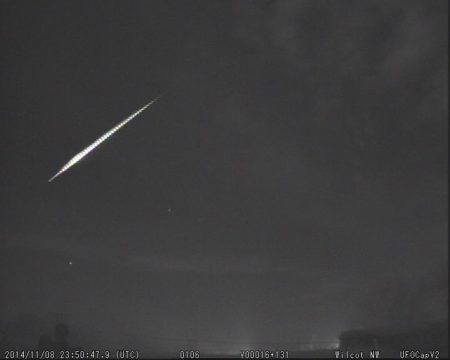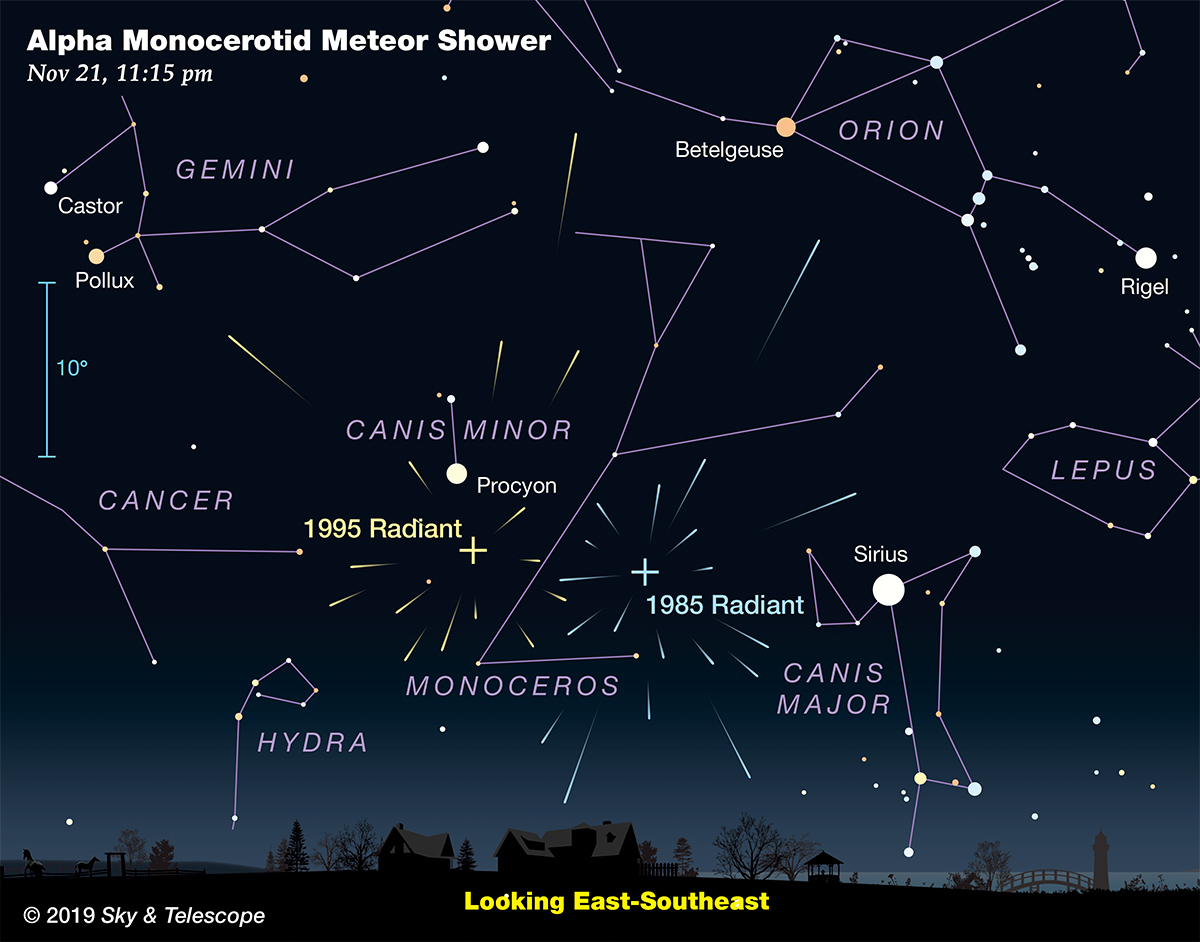Intense Meteor Outburst Expected from the Alpha Monocerotids – Sky & Telescope
Circle the date November 21st on your calendar, when a brief but potentially spectacular meteor storm might light up the night.

A confirmed Alpha Monocerotid meteor photographed on November 8, 2014.
United Kingdom Meteor Observation Network (UKMON)
What’s rarer than seeing a unicorn? How about a unicorn spitting meteors at the rate of 400 per hour? You’ll have an opportunity to see it for yourself on Thursday night, November 21-22, when the obscure Alpha Monocerotid shower could produce upwards of 400 meteors per hour from a radiant near the star Procyon in Monoceros the unicorn. Even more amazing, the outburst is expected to last only a half-hour.
Peter Jenniskens, a senior research scientist with the SETI Institute and NASA’s Ames Research Center, along with Esko Lyytinen of the Finnish Fireball Network, have been keeping tabs on the shower for years. During outbursts, such as those that occurred in 1925 and 1935, activity reached meteor-storm levels with a zenithal hourly rate (ZHR) of more than 1,000. Activity rose to near-storm levels again in 1985 and 1995 with ZHRs around 700 and 400. ZHR is an idealized number based on how many meteors a single observer would see if the radiant were overhead in a dark sky during shower maximum.
The source of the Alpha Monocerotids is unknown, but the stream’s orbital characteristics point to a long-period comet with a period of about 500 years. This nameless visitor deposited a dense, narrow ribbon of debris in the distant past with a half-width of only around 55,000 kilometers, equal to the distance from the center of Earth to the geostationary satellite belt.

This map shows the sky facing southeast from Philadelphia at 11:50 p.m. EST on Nov. 21. Two Alpha Monocerotid radiants are marked, 1985 and 1995. The 1995 radiant was determined by multi-station photography.
Jenniskens and Lyytninen expect Earth to barrel through the swarm of cometary dust bunnies on the night of November 21-22, centered on 4:50 Universal Time on November 22nd (11:50 p.m. EST on November 21st). Circumstances are nearly identical to the 1995 outburst when the ZHR briefly reached 400. Depending on exactly how close Earth passes to the center of the debris trail we could see storm rates like those in 1925 and 1935 — years when Earth presumably shot directly through the center — or “scraped bottom” with counts closer to 100 meteors an hour.
The shower’s brevity means you don’t want to be late to the show. Past observations indicate that peak activity will last a mere 15 to 40 minutes! Lyytinen recommends getting out no later than 4:15 UT, Nov. 22nd (11:15 p.m. EST on Nov. 21st). The radiant, located in eastern Monoceros, rises around 10 p.m. local time, so it will be relatively low in the eastern sky for observers in the eastern half of the U.S. and Canada at shower maximum. South Americans have the best seats while skywatchers in Africa and Western Europe will catch it in the hour or two before dawn. No worries about the Moon — the 22%-illuminated crescent won’t rise until after 2 a.m. local time.
If the radiant is visible from your location during this tiny observing window, you might just see a rare spectacle. Jenniskens, who joined members of the Dutch Meteor Society to monitor the shower in 1995, didn’t know exactly what to expect but wasn’t disappointed. He describes the experience in his book Meteor Showers and Their Parent Comets:
“Suddenly, around 0:10 UT, three meteors radiated from a point on the border of the constellations Canis Major and Monoceros, 15° away from the position (radiant) given in past accounts. And this time it did not stop after just a few. Meteors started pouring out of Canis Minor, falling left and right, up and down. Bright meteors too . . .”
Because the radiant’s position varies from outburst to outburst, the map shows both the 1985 and 1995 locations. Suffice to say if you see a spray of sparks emanating from near Procyon, the shower will be under way. Alpha Monocerotids are swift, with a velocity of 64 kilometers per second, similar to the Perseids. Observers across the planet are strongly encouraged to make detailed observations of the shower — the time of the peak and radiant position are essential for predicting its future return.
Get your cameras ready too. Digital photography has progressed by leaps and bounds since the last maximum, offering amateurs a shot at capturing the elusive event. Coordinated photographic efforts by observers living miles apart can provide positional data on individual, incoming meteoroids.
Jenniskens and the other teams participating in the 1995 observation campaign discovered some oddities about the Alpha Monocerotid meteoroids. For one, the comet crumbs penetrated 5 kilometers deeper in the atmosphere than either Perseids or Orionids of similar brightness and speed, which could indicate a denser, less fragile composition. Spectra obtained by astronomers at the Ondrejov Observatory also revealed a lack of sodium, a volatile element lost by heating or by radiation. Since the shower grains have completed only one orbit since their release from the parent comet and do not come close enough to the Sun for solar heating to be significant, Jenniskens suspects they may be pristine samples of the comet’s crust.
If bad weather forces you to miss the potential outburst, Esko Lyytinen writes that the shower has staying power. It lies close enough to Earth’s orbit to produce future outbursts for the next several centuries. But if you do have clear skies, I’m eager to hear what you see during that precious half-hour. Please share them in the comments area. Good luck!





